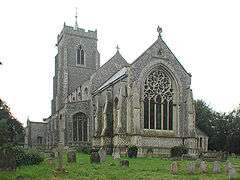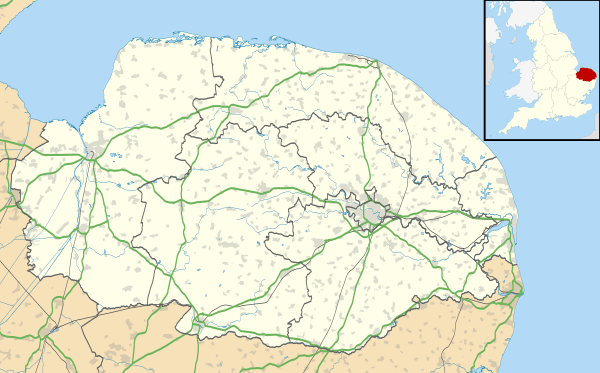Martham
Martham is a village and civil parish in the English county of Norfolk. It is situated some 15 km (9.3 mi) north-west of the town of Great Yarmouth and 30 km (19 mi) north-east of the city of Norwich.[1]
| Martham | |
|---|---|
 St Mary, Martham | |
 Martham Location within Norfolk | |
| Area | 11.84 km2 (4.57 sq mi) |
| Population | 3,569 (2011) |
| • Density | 301/km2 (780/sq mi) |
| OS grid reference | TG455185 |
| Civil parish |
|
| District |
|
| Shire county | |
| Region | |
| Country | England |
| Sovereign state | United Kingdom |
| Post town | GREAT YARMOUTH |
| Postcode district | NR29 |
| Police | Norfolk |
| Fire | Norfolk |
| Ambulance | East of England |
The civil parish has an area of 11.84 km2 (4.57 sq mi) and in the 2001 census had a population of 3,126 in 1,267 households, the population including Cess and increasing at the 2011 Census to 3,569.[2] For the purposes of local government, the parish falls within the district of Great Yarmouth. In recent years the population has expanded with considerable housing being constructed. Bus service to Great Yarmouth is regular.[3] There was a station in the village adjacent to a level crossing on Rollesby Road Martham railway station, but this closed in 1959, when the entire line from Great Yarmouth to North Walsham was eliminated.[4] The station buildings stood for another 30 years.
Education is available in the village from Early Years to aged 16. Martham Primary & Nursery[5] caters for children up to year 6, with Flegg High School taking students from year 7 to year 11. Post 16 education is available at other establishments outside of Martham.
The village has several Georgian houses, a large village green, covering three areas of greensward and two duck ponds. Near St Mary's church Church of England, Ferrygate Lane leads to Martham Ferry, where an unusual floating swing bridge crosses the River Thurne. The bridge leads to Heigham Holmes, an island nature reserve, which can only be accessed by the public on special occasions.[6] About 2 km (1.2 mi) to the north of the village is Martham Broad, a 140 acres (57 ha) nature reserve, which is not navigable by boat.
The Saxons settled in Martham around AD601[7] and gave the village its name, "the ham of the martens", the home of the polecats.[8][9]
The Anglican missionary Anna Hinderer died in the village in 1870.[10][11]
Notes
- Ordnance Survey (2005). OS Explorer Map OL40 - The Broads. ISBN 0-319-23769-9.
- "Parish population 2011". Archived from the original on 11 October 2016. Retrieved 25 August 2015.
- Office for National Statistics & Norfolk County Council (2001). Census population and household counts for unparished urban areas and all parishes. Retrieved December 2, 2005.
- Wrottlesley, A.J.F. (1970). The Midland and Great Northern Joint Railway. pp. 27, 37, 53, 93, 140, 162, 198, 17. ISBN 0-7153-4340-8.
- "Archived copy". Archived from the original on 3 February 2017. Retrieved 27 March 2020.CS1 maint: archived copy as title (link)
- "Highham Holmes open day". Broads Authority. Archived from the original on 28 September 2011. Retrieved 29 August 2011.
- Meakin, Ann (1996). Glimpses into the history of the village of Martham. Ann Meakin. ISBN 0-9529876-0-0.
- http://www.martham.gov.uk/History/history.htm
- Women's Institute, Norfolk Federation (1994). The Norfolk Village Book. Countryside Books. p. 142. ISBN 1-85306-092-5.
- Anna Hinderer, DACB, Retrieved 19 March 2017
- http://www.greatyarmouthmercury.co.uk/news/author_described_as_cultural_gem_is_celebrated_1_4420553
External links
| Wikimedia Commons has media related to Martham. |
- Map sources for Martham.
- Information from Genuki Norfolk on Martham.
- Martham Parish Council website
- Martham Local Weather website
- Martham Primary & Nursery
- Flegg High School
- The History of Martham